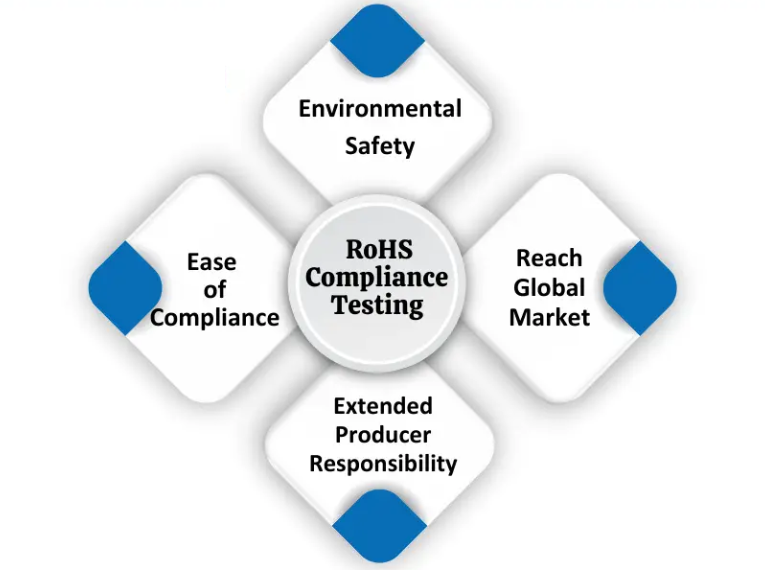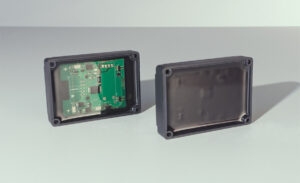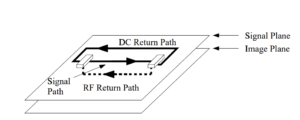RoHS Directive applies to electrical and electronic equipment that is dependent on electric or electromagnetic fields to work properly.
Contact suppliers and ask if their materials, parts, components, etc. contain any of the six restricted substances.
- Lead, cadmium, mercury, hexavalent chromium, PBB, or PBDE flame retardants.
- Suppliers should provide a declaration which could be in various formats. Some will provide this information on websites.
Is there any doubt about the presence of a restricted substance?
- Use the decision tree that appears below in this guide to decide if the analysis is advisable.
- The frequency of analysis will depend on many factors, including your relationship with suppliers.
- Analysis frequency also depends on the potential environmental impact of inadvertent use of a restricted substance. The authorities will expect more frequent analysis of parts in products sold in very large quantities than in those sold in relatively small numbers.
Keep supplier declarations and analysis data in a technical file.
Some suppliers may not change their part numbers so separation of RoHS compatible and RoHS incompatible parts will be needed.
The authorities will expect to see this in case of a suspected infringement.
Your customers may ask about RoHS compliance and expect you to provide a declaration.
Introduction to the RoHS Directive
The Restriction of the Use of Certain Hazardous Substances (RoHS) Directive comes into force on 1st July 2006. From this date, producers of certain categories of electrical and electronic equipment will not be able to place on the market products that contain six banned substances unless specific exemptions apply. This much is clear, but what will producers be expected to do by the authorities?
What is a compliant product?
The RoHS Directive applies to equipment that is within the scope of the Directive. None of the “homogeneous materials” within compliant products must contain the six restricted substances at concentrations above the “maximum concentration values”.
Who is responsible?
Producers of equipment are held responsible for ensuring that their products do not contain the six restricted substances. The Directive does not cover components or sub-assemblies so the equipment producers will have to take their steps to ensure that all parts and materials used in their products do not contain restricted substances. “Producer” means any person who, irrespective of the selling technique used:
- manufactures and sells electrical and electronic equipment under his brand;
- resells under his brand equipment produced by other suppliers; or
- imports or exports electrical and electronic equipment on a professional basis into a member state. It is clear from this that there will be circumstances in which it is not the actual manufacturer of a product who will assume the “producer” responsibilities.
What is a homogeneous material?
A homogeneous material is a single substance such as a plastic, for example, the PVC insulation on insulated copper wire. Components such as capacitors, transistors, and semiconductor packages are not “materials” but will contain several different materials. For example, a semiconductor package will contain at least six as shown below.
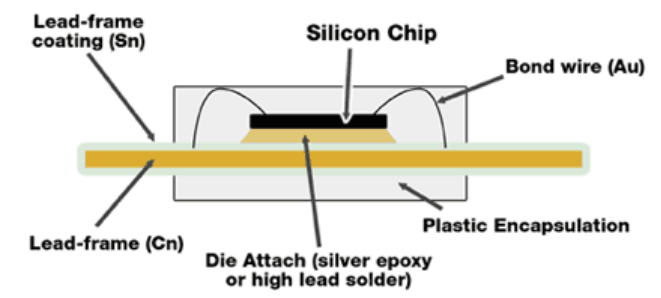
What will Producers be required to do to comply with RoHS legislation?
By placing their products on the market, producers are declaring that these comply with RoHS legislation. This is the basis for “self-declaration” which is used for several other European Union directives. There are no requirements for the application of a specific mark or testing by independent third parties. However, the authorities within each Member State will carry out market surveillance and conduct checks on products. If they find that a product does not comply with RoHS legislation, the producer will be asked to show that due diligence has been used and he has taken “reasonable steps” to comply.
Producers will be expected to use two approaches to comply:
- Obtain declarations of compliance for materials, components, and other parts from suppliers.
- Selected analysis.
Where authorities find non-compliant equipment, they will audit the producer’s records, which should be in the form of a “technical file”. These files must be kept for at least four years.
Compliance Declarations
Equipment producers will need to obtain materials declarations or certificates of compliance from their suppliers. The minimum that these need to state in the declaration is that the materials, parts, or components may be used to produce RoHS-compliant equipment. This confirmation must be for individual materials, not for whole components (due to the homogeneous material requirement mentioned above).
Some component manufacturers produce materials declarations for a range of products, for example, one declaration for all types of Quad Flat Pack (QFP) packages. This is reasonable because all of these would consist of the same materials and so a declaration for one part number would be identical to one for another part in the same range, and because the composition of all of the materials is identical.
Equipment producers often obtain a part regularly from a supplier and these can, over a while, be from several batches. Separate declarations for each batch should not be necessary unless the manufacturer has made a change to the production process. However, equipment producers need to be aware that batch-to-batch variation may occur.
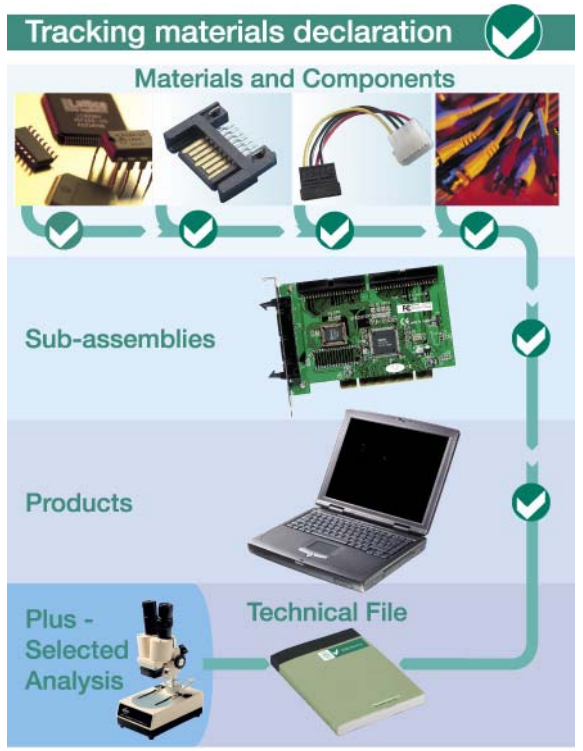
The absence or presence of the six restricted substances is tracked throughout the supply chain. For example, a notebook PC manufacturer will obtain declarations on individual components and sub-assemblies, as well as carry out selected analyses. Materials declarations may be in paper or electronic format.
Selected analysis – when to analyze?
There may be occasions when it will be advisable for a producer to carry out an analysis to determine whether a restricted substance is present. There are various reasons why this might be necessary, but the decision of whether to analyze is left to the equipment producer. A decision tree as below can be used to help producers decide whether analysis is necessary
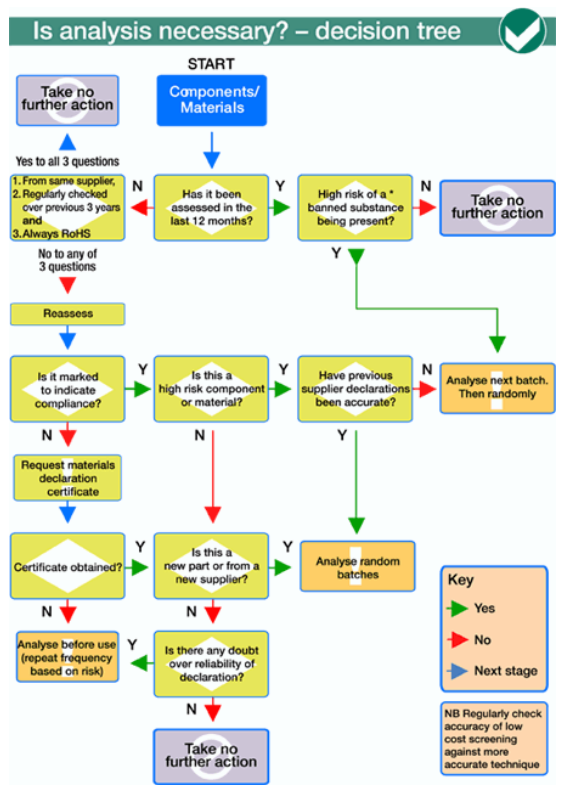
Certain materials have a relatively high risk of containing a restricted substance. For example, PVC obtained from the Far East often contains lead and cadmium and these are occasionally found in other types of plastics.
In addition, there may be significant variation between different batches, and therefore an equipment producer using multiple batches should be aware of this issue.
To a significant extent, the decision whether to analyze will depend on the relationship with the supplier. Analysis will be needed less often for items from well-established suppliers with proven reliability than from new “unknown” suppliers. In some cases, a producer may never need to analyze.
How and what to analyze
It is unnecessary and far too costly to analyze every material. Only materials that are likely to contain a restricted substance need to be checked. For example, in the case of the semiconductor package, the only location where a restricted substance may occur is in the tin-plated termination coating as an impurity or because tin/lead alloy was used instead of tin. Connectors may contain restricted substances both in the plastic parts (lead, cadmium, or PBDE) and in electroplated tin coatings.
The recommended procedure for routine analysis to check components and materials is a two-step approach. In all cases, a producer should ensure that the analyst has expertise in the analysis of electronic components.
Step 1 – Routine screening.
The first step is to use a screening technique such as energy dispersive X-ray analysis (EDXRF). This has sufficient accuracy to determine:
- If no Pb, Cd, Cr, Hg, or Br are present or
- If Pb, Cd, Cr, Hg, or Br are present at “significant” concentrations.
Two types of EDXRF are available. Handheld equipment is quick and easy to use but not as accurate as desktop machines. Both types have limitations that should be clearly understood by the analyst. There are other routine screening methods available.
Step 2 – More accurate analysis
This will be necessary under the following circumstances:
- Pb, Cd, or Hg was found at “borderline” concentrations – additional, more accurate, analysis would be needed. The method used will depend on the material.
- Cr was detected
- Br was detected
Under these circumstances, it would be advisable to ask a professional analytical laboratory to analyze suspect materials.
List of categories of equipment that will need to comply with RoHS legislation
The list of products below each category heading is illustrative and not exhaustive.
Large household appliances
Such as large cooling appliances; refrigerators; freezers; other large appliances used for refrigeration, conservation, and storage of food; washing machines; clothes dryers; dishwashing machines; cooking; electric stoves; electric hot plates; microwaves; other large appliances used for cooking and other processing of food; electric heating appliances; electric radiators; other large appliances for heating rooms, beds, seating furniture; electric fans; air conditioner appliances; other fanning, exhaust ventilation and conditioning equipment.
Small household appliances
Such as vacuum cleaners; carpet sweepers; other appliances for cleaning; appliances used for sewing, knitting, weaving, and other processing for textiles; irons and other appliances for ironing, mangling, and other care of clothing; toasters; fryers; grinders, coffee machines and equipment for opening or sealing of containers or packages; electric knives; appliances for hair- cutting, hair drying, tooth brushing, shaving, massage, and other body care appliances; clocks watch and equipment to measure, indicate or registering time; scales.
IT and telecommunications equipment
Such as centralized data processing; mainframes; minicomputers; printer units; personal computing; personal computers, including the CPU, mouse and keyboard; laptop computers, including the CPU, mouse and keyboard; notebook computers; notepad computers; printers; copying equipment; electrical and electronic typewriters; pocket and desk calculators; other products and equipment for the collection, storage, processing, presentation or communication of information by electronic means; user terminals and systems; facsimile; telex; telephones; pay telephones; cordless telephones; cellular telephones; answering systems; other products or equipment of transmitting sound, images or other information by telecommunications.
Consumer equipment
Such as radio sets; television sets; video cameras; video recorders; hi-fi recorders; audio amplifiers; musical instruments; and other products or equipment for recording or reproducing sound or images, including signals or other technologies for the distribution of sound and images than by telecommunications.
Lighting equipment, (including electric light bulbs and household luminaires)
Such as luminaires for fluorescent lamps; straight fluorescent lamps; compact fluorescent lamps; high-intensity discharge lamps, including pressure sodium lamps and metal halide lamps; low-pressure sodium lamps; and other lighting equipment to spread or control light.
Electrical and electronic tools (with the exception of large-scale stationary industrial tools)
Such as drills; saws; sewing machines; equipment for turning, milling, sanding, grinding, sawing; cutting; shearing; drilling; making holes; punching; folding; bending or similar processing of wood, metal and other materials; tools for riveting, nailing or screwing or removing rivets, nails, screws or similar uses; tools for welding, soldering or similar use; equipment for spraying, spreading, dispersing or other treatment of liquid or gaseous substances by other means; tools for mowing or other gardening activities.
Toys, leisure, and sports equipment
Such as electric trains or car racing sets; hand-held video game consoles; video games; computers for biking, diving, running, rowing, etc.; sports equipment with electric or electronic components; and coin slot machines.
Automatic dispensers
Such as automatic dispensers for hot drinks; automatic dispensers for hot or cold bottles or cans; automatic dispensers for solid products; automatic dispensers for money; and all appliances that deliver automatically all kinds of products.
The information contained in this guide is general and is not intended to address the circumstances of any particular individual or entity.
EMSxchange Enables you to select a Printed Circuit Board, PCB Assembly, cable & wire harness assembly, and box-build suppliers meeting your Required Electronic Manufacturing Capability, capacity, and Certification Criteria from a global Electronic contact manufacturer base.
EMSxchange takes complete responsibility and ownership for your electronic manufacturing process and all its deliverables from contract manufacturing supplier selection to manufacturing to quality inspection to shipment and delivery to your door.
EMSxchange Electronic Manufacturing Partners Profile includes:
Argus Systems (AESPL) – PCB, PCBA, Cable Assembly, Box Build, Testing.

